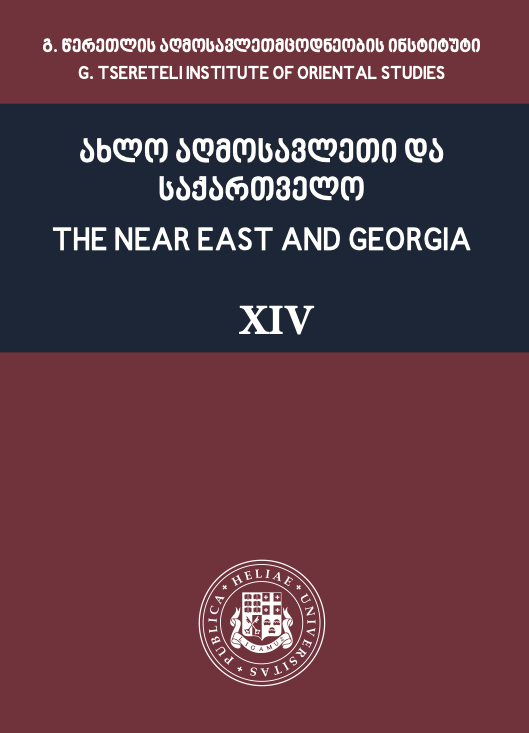DAGGERS OF TSULUKIDZE SATAVADO AS AN INDICATOR OF POLITICAL ORIENTATION (60-70S OF THE 17TH CENTURY)
DOI:
https://doi.org/10.32859/neg/14/422-432Keywords:
The Satavado of the Tsulukidzes, Iranian influence, Persian dagger, Nikortsminda frescoesAbstract
The Satavado of the Tsulukidzes was formed in the second half of the 15th century. Later, the number of their estates increased even more and by the second half of the 17th century, they also owned many villages in Racha (In Eastern Georgia). It was quite a wealthy and distinguished family. In the first half of the 17th century, the head of the Tsulukidze House may have been Kaikhosro, the successor of Davit Tsulukidze and His contemporary was Paata Tsulukidze.
It is known from the history of Georgia that Paata Tsulukidze was “cursed” by King Giorgi III of Imereti (1604-1639). He confiscated his estates, after which he went to Odishi (In Eastern Georgia) and very soon appears as the deputy of Levan Dadian. Paata Tsulukidze was in favor of Levan Dadiani's plan to dominate Western Georgia and shared Dadiani's Iranian political orientation. King Bagrat III of Imereti (1660-1681) reconciled the long-time "cursed" Tsulukidzes; however, Merab, the son of Paata Tsulukidze, maintained the hostility towards the king of Imereti for some time. The political anarchy that we are facing in Imereti during this period of time became an aid for Tsulukidze and in the 1760s and 1770s, they regained their lands confiscated by King Giorgi.
Merab Tsulukidze appears as the head of the Tsulukidze family during the above-mentioned period. The latter, as he says himself, was "raised" by Levan II Dadian, he regained the lost lands and adjoined new territories to his lineage, as well.
In the 1770s, the Tsulukidzes declined during the reign of George III, and rose again.
The clothes of Tsulukidze family who are depicted on the frescoes of the Nikortsminda cathedral, correspond to the Iranian fashion trends which were common in the 17th century Georgia. However, in this case, their daggers attract our attention.
At the Nikortsminda cathedral we can see the depiction of Varadebul, the son of Bejan, Bejan Tsulukidze (he is the son of Paata Tsulukidze, Bejan the second, brother of Merab Tsulukidze), Sazua Chijavadze and her spouse, Elene Kortodze and her spouse Lomina Tsulukidze (1660-1670) (picture 1). On the second fresco Merab Tsulukidze is illustrated with his wife and son. (1660-1670) (picture 2). Sharply Curved dagger hangs on the right side of the Bejan’s son. As for the second fresco, we can see the slightly curved dagger of the Merab Tsulukidze’s son, Kaikhosro.
The curved double-edged dagger from Iran is called Khanjar (Bebut). Pers. - خنجر [khanjar].
The word khanjar laid a foundation of referring similar shaped daggers in many languages and countries as Khanjar.
As the specialists of this field claim, in order to clarify the origin of cold weapon, the primary importance should be given to its handle. Defining cold weapon’s origins only based on its blade is considered to be wrong. The handle of the Iranian dagger is I-shaped and was made from Ivory and horn as well as iron and steel.
The daggers (Bebut) depicted on the frescoes of Merab Tsulukidze and his family are of Iranian origin. Apart from Tsulukidze frescoes, one can see curved Iranian dagger on the other frescoes of the 17th century western Georgia’s cathedrals. For instance, the fresco of Levan II Dadiani at the church of the assumption of Virgin Mary in Tsaishi, the fresco of Kaikhosro Chikvani at the St. George’s church of Nakuralesh, the fresco of Bava and Katsia Chikvani at the same cathedral.
On the 17th century noblemen frescoes of Western Georgia, one can see that the straight-shaped daggers (Caucasian Kama). As it seems, this particular shape was common. As for the curved dagger of Iranian origin (Bebut), it can be seen on the ancestral frescoes of the families (Merab Tsulukidze and his family, Chikvan-Lipartians) who had a close relationship with the principality of Odishi and who shared Levan II dadiani’s Iranian political orientation.




